#Lemminkäinen's Mother
Photo


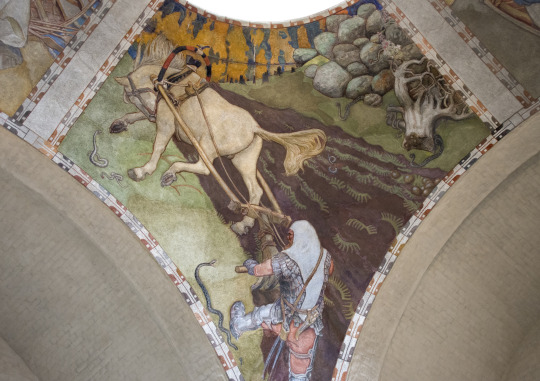
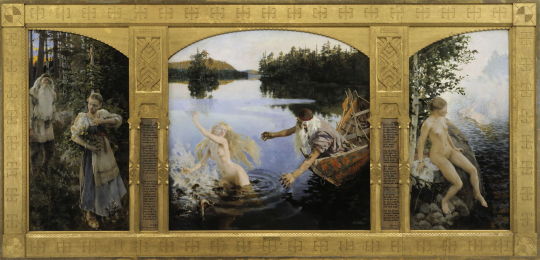






Akseli Gallen-Kallela (1865–1931), illustrations from the Kalevala
The Defense of the Sampo (Sammon puolustus), 1896
Lemminkäinen’s Mother (Lemminkäisen äiti), 1897
Ilmarinen Ploughing the Field of Vipers (Ilmarinen kyntää kyisen pellon), 1928
Aino Myth, Triptych, 1891
By the River of Tuonela (Tuonelan joella), 1903
Joukahainen’s Revenge (Joukahaisen kosto), 1897
Lemminkäinen at the River of Fire (Lemminkäinen tulijoella), 1920
Kullervo Cursing (Kullervon kirous), 1899
The Abduction of Sampo (Sammon ryöstö), 1905
Forging of the Sampo (Sammon taonta), 1893
#Kalevala#Akseli Gallen-Kallela#Akseli Gallen Kallela#art#mythology#Finland#Finnish mythology#Sampo#Kullervo#Forging of the Sampo#The Abduction of Sampo#The Defense of the Sampo#Lemminkäinen's Mother#Ilmarinen Ploughing the Field of Vipers#Aino#Lemminkäinen#Tuonela
95 notes
·
View notes
Text


same vibes
previously in the series: click here
#blind channel#joel hokka#lemminkäisen äiti / lemminkäinen's mother (akseli gallen-kallela 1897)#this is bad and i apologize#particularly to all the finnish peeps out there lol#joel-lemminkäinen saw the swan of tuonela (the afterworld) and passed away#it's okay he's in a better place now 🙏#bc+art
29 notes
·
View notes
Text
.
saw my mother for the first time in three years like ten days ago and she still knows nothing about me because she doesn't ask and she's messaged me like twice after so i guess i was right and i really do not have parents, and i'm going through the worst flare up of my chronic illness in like three years and i burnt the roof of my mouth and then had a teeth check up the morning after and then i went home just to go back to the same building a couple hours later to talk to a strange new doctor about my mental health problems and i was not really prepared for how intense the questioning was and now they're considering ect and i'm exhausted and i still don't have an answer on what my financial situation is going to be and that's been going on for 3 and a half months already and my internet keeps going out when i'm trying to publish a fic or read the before classes start! readings and my first class is starting tomorrow and i'm on my period and i'm going to snap
also i'm just so tired of being asked if i have people to turn to if everything goes bad bc it's like hmm i know this is standard questioning but do i really have to keep saying i have no support system out loud? like no i don't have anyone <3 i know i can call the emergency number but i'm hoping this time they won't hang up on me or kick me out of the er which have both happened before when i was suicidal <3
destroyed mentally by having to say things out loud i guess instead of pretending like it isn't happening and disassociating for weeks on end
AND no one told me that if i DO get a therapist it's supposed to be one or two times a week???? i have NO money??? i was trying to figure out how to come up with an extra 40 euros a month 160 is unthinkable???
also my mother was very clear that i cannot go home even if it's staying with a friend and just coming to get my things when my f*ther is out. so idk how long it will be until he's dead and i had so many notebooks and pictures from when i was a child along with all my books and such. i didn't bring a lot when i moved across the ocean.
not even sure how psychotherapy is supposed to help the crushing weight of never having been loved enough in my life with many attempts at getting to know people ending with 'oh you're too hard to love' on top of whatever did or didn't happen in my childhood. which i'm not even making up. multiple people have said that to my face. and i'm cold and distant and i don't let anyone close <3
people like 'you're so kind but so cold' okay i contain multitudes???
#little rant bc too much is going on#deleteing later#txt#my mother treats me like don't ask questions you don't want the answer to#abuse mention#medical#i'm not even hanging on by a thread#i'm on the bottom of the canyon staring up at the snapped rope#my icon has been Lemminkäinen's Mother bc the expression is how i feel
4 notes
·
View notes
Note
Hi Neil!
I just finished watching Dead Boy Detectives and loved it!!
I have a question about it, though:
There is a finnish painting called ”Lemminkäisen äiti” by artist Akseli Gallen-Kallela, which really reminded me of the washer woman painting !! :))
I was wondering if there was any chance that it was inspired by it or if it’s just my imagination :D? (Really cool either way)

(Here’s the painting, it’s about Lemminkäinen’s mother griefing the death of her son, based on Finland’s national epic Kalevala)
I personally have always loved that painting -- i first saw it in the Helsinki art museum in about 1997 and it was my second favourite painting there.
But I don't know the answer to your question.
2K notes
·
View notes
Text


lemminkäinen is a character in kalevala who, in order to win the hand of one of pohjola's daughters, is tasked to shoot the swan of tuoni
shooting the swan of tuoni brings doom to those who attempt it, and lemminkäinen even before attempting this is attacked by a man that shoots him into the tuoni river and eventually is described to be "shattered to pieces" by the son of tuoni who protects the river the swan resides in, which i always thought was a pretty gruesome visual....he's later put back together by his own mother, but there's already a famous painting about that part!
#kalevala#finnish folklore#finnish mythology#lemminkäinen#body horror#hey i Can draw the men of finnish folklore too and not just ladies lol
162 notes
·
View notes
Text
FINNISH ART TOURNAMENT ROUND 1 POLL 9

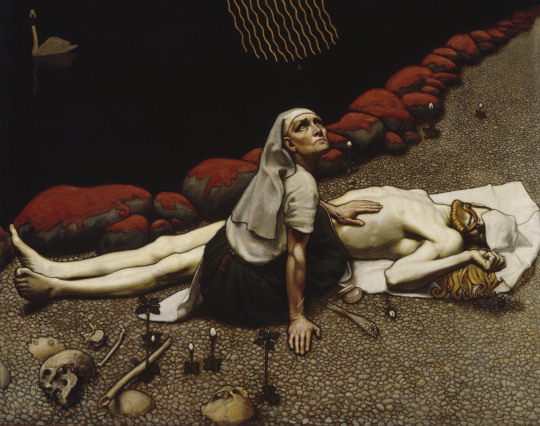
51 notes
·
View notes
Text
The Round 1 Draw is here!

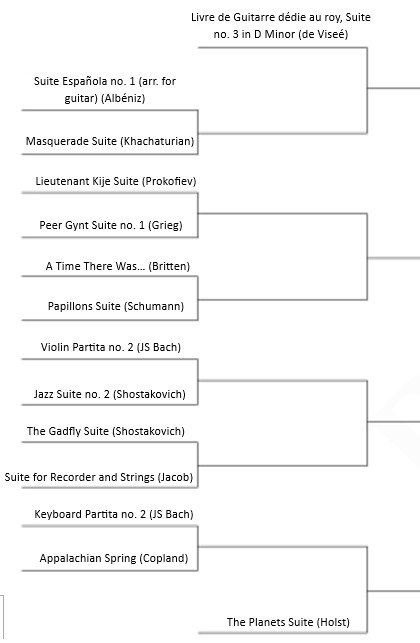

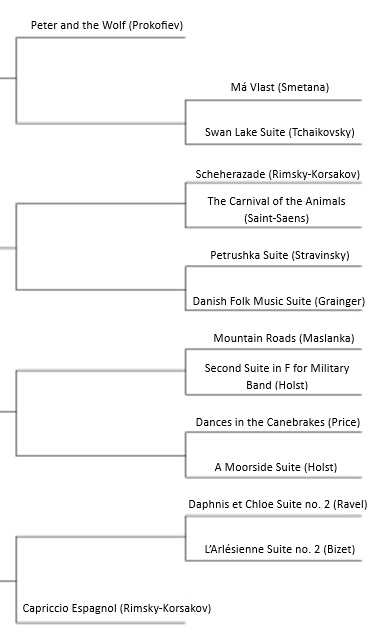
The top left:
Sleeping Beauty Suite vs Bye
Le tombeau de Couperin vs Suite in Old Style
Holberg Suite vs Lemminkäinen Suite
Caucasian Sketches Suite no. 1 vs Suite for Solo Viola
The Golden Mountains vs Carmen Suite no. 2
Lincolnshire Posy vs Der Rosenkavalier Suite
American Suite vs Cello Suite in G Major
Pictures at an Exhibition vs Children's Corner Suite
The bottom left:
Livre de Guitarre dédie au roy, Suite no. 3 in D Minor vs Bye
Suite Española no. 1 vs Masquerade Suite
Lieutenant Kije Suite vs Peer Gynt Suite no. 1
A Time There Was vs Papillons Suite
Violin Partita no. 2 vs Jazz Suite no. 2
The Gadfly Suite vs Suite for Recorder and Strings
Keyboard Partita no. 2 vs Appalachian Spring
The Planets Suite vs Bye
The top right:
Suite from Hamlet vs Bye
English Folk Song Suite vs Mother Goose Suite
Orchestral Suite no. 3 in D vs St Paul's Suite
The Firebird Suite vs Symphonic Dances
Romeo and Juliet Suite No. 2 vs Dance Suite
Giselle Ballet Suite vs Keyboard Partita no. 6
First Suite in E-flat for Military Band vs Magnificant in Bb Major
The Nutcracker Suite vs Violin Partita no. 3
The bottom right:
Peter and the Wolf vs Bye
Má Vlast vs Swan Lake Suite
Scheherazade vs The Carnival of the Animals
Petrushka Suite vs Danish Folk Music Suite
Mountain Roads vs Second Suite in F for Military Band
Dances in the Canebrakes vs A Moorside Suite
Daphnis et Chloe Suite no. 2 vs L’Arlésienne Suite no. 2
Capriccio Espagnol vs Bye
Please note all of these matches (including byes) were randomly allocated using a random number generator and I will not be making any changes. I will post 1 poll per day starting from 12:00 am GMT time on the 1st of December (in 24 hours time at time of posting), with each poll lasting for a week to give everyone time to listen to each submission.
35 notes
·
View notes
Text



Details from Lemminkäisen äiti (Lemminkäinen's Mother) by Akseli Gallen-Kallela, Finnish, ca. 1897, tempera on canvas, Ateneum
25 notes
·
View notes
Text
Regulus' Brother

Combining my two passions: Marauders and Kalevala. (This is probably very sacrilegious.)
In Kalevala Lemminkäinen's mother saves his son from the river of death and brings him back to life. I was playing with the idea of Sirius coming to the rescue of his brother. I have a feeling that he gets his brother back only for a short time. R.I.P.R.A.B.

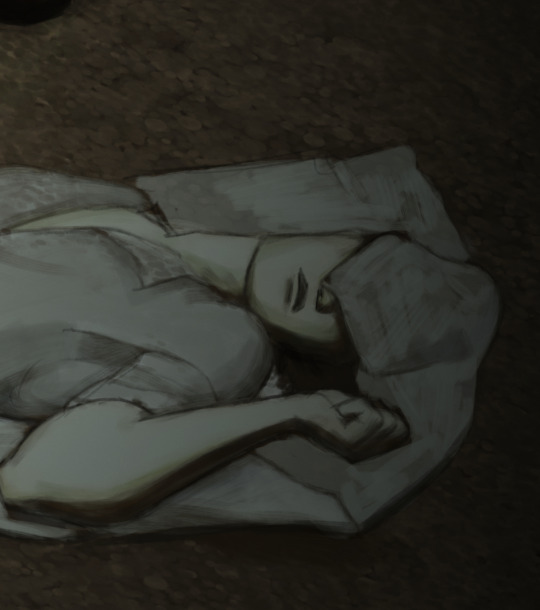
I used Gallen Kallela's painting Lemminkäisen äiti as reference.
#kalevala#regulus black#lemminkainen#lemminkaisen aiti#nordic myths#potter#harry potter#sirius black#sirius#regulus#rab#r.a.b.#regulus death#myth#mythical#suomi#finland#finnish
17 notes
·
View notes
Text

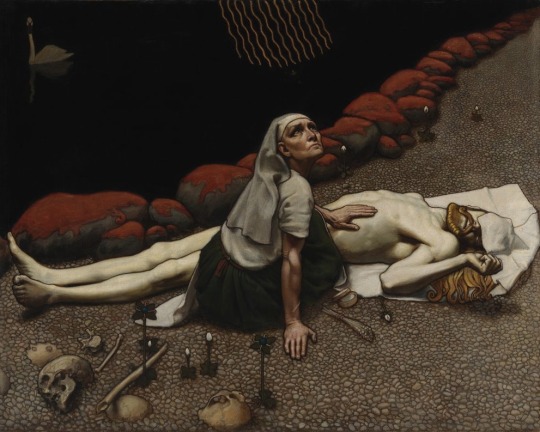
revenge of the sith, dir. george lucas (2005) // the mother of lemminkäinen by akseli gallen-kallela (1897)
9 notes
·
View notes
Text

Recovery of Lemminkäinen's head from the river of Tuonela (Hades).
Lemminkäinen was a worrior who met his death in a cruesome manner and his body was chopped into pieces and drowned in a river. His mother goes to look for the pieces by raking the river. She finds the pieces of his body and with the help of a bee who flies to heavens to get ointments that bring Lemminkäinen back to life.
Falling in love wiht Kalevala. It's a book of poems based on Karelian folklore.
#kalevala#lemminkainen#lemminkäinen#death#northern mythology#myth#mythology#karelian mythology#nordic mythology#finland#russia#karelia#finnish#karelian
12 notes
·
View notes
Text

Joseph Alanen, Lemminkäinen's Mother at the River of Tuonela
8 notes
·
View notes
Text

'Lemminkäinen's Mother at the River of Tuonela'. Robert Wilhelm Ekman. 1862.
39 notes
·
View notes
Text
The differences and similarities of Estonian and Finnish folklore! Part 2
Magic, spells, and shamanistic practices are prominent elements in both the Kalevala and Estonian folklore, showcasing the belief in supernatural powers and the utilization of magic for a wide range of purposes.
The Kalevala features several characters who possess magical abilities, and magic plays a central role in the epic's narratives. The most notable characters associated with magic are Väinämöinen, Ilmarinen, and Lemminkäinen, each of whom employs their magical skills for different purposes.
Väinämöinen, the legendary bard, is a master of song and music. His songs have powerful, often magical effects, such as:
Healing: Väinämöinen's singing can cure illnesses, injuries, and ailments.
Control of Nature: His songs can calm turbulent waters, summon winds, and invoke natural forces.
Creation: Väinämöinen's singing is instrumental in the creation of various artifacts and tools.
Ilmarinen, the skillful blacksmith, uses his craftsmanship and knowledge of the magical arts to create extraordinary items. Notable examples include:
The Sampo: Ilmarinen forges the Sampo, a mystical object that brings prosperity and abundance to its possessor.
Other Enchanted Items: Ilmarinen crafts numerous other magical objects, such as the plow of Sariola and the Lid of Tuonela.
Lemminkäinen is a daring and adventurous character who displays magical abilities in his quests, such as:
Resurrection: Lemminkäinen is resurrected from the dead by his mother, and he also restores life to animals he has killed in hunting.
Shape-shifting: In some stories, Lemminkäinen has the ability to change his form to achieve his goals.
Estonian folklore often includes shamans or wise individuals with special knowledge and powers. They act as intermediaries between the human and spirit worlds, offering services such as:
Healing: Shamans use various rituals, herbs, and incantations to cure illnesses and provide remedies.
Divination: They use divination practices to foresee the future, answer questions, and provide guidance to their communities.
Protection: Wise folk protect against malevolent spirits and harmful magic through charms, amulets, and spells.
Estonian folklore contains a wealth of tales featuring magical items that hold the power to bring fortune, protect against harm, or bestow supernatural abilities upon their owners. These enchanted objects are central to many traditional narratives and often play a crucial role in the characters' quests and adventures.
Magical rings are a recurring motif in Estonian folklore. These rings are often bestowed by supernatural beings or found through heroic quests. They grant their owners special abilities, such as invisibility, the power to control animals, or the ability to understand the language of birds.
Amulets and talismans are protective items that shield their wearers from harm, evil spirits, and curses. These objects are believed to have the power to bring good fortune, ward off malevolent forces, and provide protection during times of danger.
Some Estonian folklore tales feature enchanted cloaks or garments that render their wearers invisible or give them the ability to fly. These items are typically found or gifted by mystical beings and are used to undertake daring adventures or evade enemies.
Magical staffs or staves are instruments of power in Estonian folklore. They can be used for a variety of purposes, such as controlling the weather, summoning spirits, or performing feats of strength and magic.
Certain magical tales involve mystical musical instruments or tools. These instruments, often made of unique materials, produce enchanting melodies or sounds that can have a profound impact on the world, from calming storms to healing the sick.
Golden apples and other supernatural fruits are sometimes sought after in Estonian folklore. These fruits are associated with abundance and good fortune. Their discovery or possession can bring prosperity to individuals or entire communities.
Certain stones and crystals in Estonian folklore are imbued with magical properties. They might reveal hidden truths, offer protection, or grant the power to control natural elements.
In some stories, characters come across objects that grant them a limited number of wishes. These wishes can be used for various purposes, including acquiring wealth, solving problems, or helping others.
The acquisition of these magical items often involves embarking on quests, interacting with supernatural beings, or completing specific tasks. These narratives emphasize the importance of bravery, resourcefulness, and virtue in obtaining these items.
These enchanted objects often serve as symbols in Estonian folklore, representing themes like the pursuit of knowledge, the struggle between good and evil, and the balance between the human and supernatural worlds.
Estonian folk traditions include a wide variety of incantations and charms, known as "loitsud" or "värsid," which are recited to influence the natural and supernatural realms. These spells can be used for purposes like:
Ensuring good harvests and agricultural success.
Protecting livestock and homes from harm.
Curing ailments and warding off misfortune.
Estonian folklore is rich with a diverse array of mythical beings and spirits, each with its own distinct characteristics, roles, and cultural significance. These entities are deeply ingrained in Estonian culture and have been part of the country's oral traditions for centuries.
Fairies (Haldjad): Fairies are enchanting, otherworldly beings in Estonian folklore. They are often depicted as beautiful and ethereal, residing in the natural world, particularly in forests, meadows, and near bodies of water. While they can be benevolent and helpful to humans, they are also known to have a mischievous side. Fairies are associated with the protection of nature and its creatures, and they are believed to have the power to heal or bless those who show respect for the environment
Forest Spirits (Metsavaimud): Forest spirits are guardian spirits of the forests and woodlands. They are protectors of the natural world and are considered vital in maintaining the balance of ecosystems. In Estonian folklore, it is customary to ask for permission and offer respect to forest spirits when entering their domain to avoid incurring their wrath.
House Spirits (Koduandid): House spirits are associated with the household and are believed to inhabit homes, barns, and other structures. They are caretakers of the family's well-being and can bring fortune or misfortune to the household. House spirits are often revered through offerings and rituals, and neglecting their care may lead to disturbances in the home.
Water Spirits (Veehaldjad): Water spirits are mythical beings associated with bodies of water, such as rivers, lakes, and springs. They are known for their beauty and are sometimes seen as alluring temptresses. Water spirits can be protective but may also lure unsuspecting humans into their watery realms.
Giants and Creatures of the Night (Hiiglased ja Öökullid): Estonian folklore includes stories of giants, creatures of the night, and supernatural beings that dwell in the dark. These entities often have a more ominous or malevolent reputation and may serve as cautionary figures in folklore, warning against certain behaviors or actions.
The Devil (Kurat): The Devil appears in Estonian folklore as a trickster figure, often engaging in clever schemes and making deals with humans. He is typically portrayed as both cunning and humorous. Stories involving the Devil may convey moral lessons or serve as entertainment.
They represent a connection to the natural world and the spiritual beliefs of the people. Many of these entities are not purely benevolent or malevolent but possess a complex nature, reflecting the Estonian people's deep-rooted respect for the environment and the need to coexist with the forces of the natural world. These folklore traditions have been passed down through generations, preserving the rich heritage of Estonia's mythical beings and spirits.
These stories often convey moral lessons and the importance of virtues such as courage, kindness, and resourcefulness. The magical items themselves are treasured cultural symbols, highlighting the enduring allure of the supernatural and the mystical in Estonian tradition.
Book recommendations
"Kalevipoeg" by Friedrich Reinhold Kreutzwald
"Estonian Folk Tales" by Lina Eibner-Moss
"Fairy Tales from Estonia" by Aino Kallas
"Estonian Fairy Tales" by Felix Oinas
"The Great Christopher and Other Stories" by Eduard Vilde
"The Kalevala" translated by Keith Bosley
"Finnish Folk Poetry: Epic" by Matti Kuusi
"The Maiden of Northland: A Hero Tale of Finland" by Simon Wickham-Smith
"Finnish Legends for English Children" by R.E. Anderson
"Finnish Folklore" by Marjorie Carpenter
"Myths of the Finns" by John Abercromby
#writers on tumblr#writing#writeblr#writers and poets#writerscommunity#writer things#writerblr#adventure#books#unexplained#estonia#eesti#folklore#finland
7 notes
·
View notes
Text
Cold winter: Pakkanen
PAKKANEN
Category: Finnish mythology
Pakkanen, also called Pakko or Pokkanen, is considered to be the Finnish equivalent of the English Jack Frost. And yet, you won’t find much about Pakkanen when searching.
There isn’t much info going around him on the Internet. You’ll find that the name Pakkanen means “cold” or “frost”. That Pakkanen himself is the spirit of winter, or the embodiment of the cold, or the personification of the “cold winter weather”. You will find that he is the son of Puhuri, the North Wind, which usually takes the shape of a giant eagle; and maybe you’ll find that his mother is “Louhi the witch”. And you’ll find mentions of how traditional Finnish poems ask Puhuri and his son Pakkanen to be gentle, and to not inflict humans chills or frostbites.
But not much more…
To learn about Pakkanen you actually have to look at The Kalevala, THE epic of Finnish culture, because Pakkanen is actually a character in this poetic reconstruction of Finnish myths.
For more information about the Kalevala, I invite you to look at my previous post about the Finnish sorcerer-hero Väinämöinen, in my “Magical Summer” series. Now, Pakkanen appears on the 30th canto/section of the Kalevala.
In this section, Lemminkäinen (another one of the sorcerer-heroes of the Kalevala) decides to take revenge on Louhi, the wicked witch-queen, who attacked his people and nation. So he sails on a boat towards Louhi’s realm, Pohjola, in an attempt to vanquish or punish the dark sorceress. Louhi, noticing this, summons Pakkanen and orders him to go freeze the ocean on which Lemminkäinen sails.
Now, Pakkanen is described Louhi’s beloved son, who was taught and instructed by her, and he is described as both a “son of evil parents” and the hero/champion of evil. If you look at an English translation of the Kalevala, you might not see the name “Pakkanen” appearing due to how this word literally means “frost”. It is a similar way to how Nyx or Ouranos from Greek mythology can be literally translated as “Night” or “Sky”. As a result, to make clear we are talking about the mythological character, translators we don’t settle with a “Frost” with a cap can mention things such as “Great Frost”, “Dark Frost” or “Frost-Fiend”.
On his way to the ocean, Pakkanen is described as taking all the leaves off the forest, robbing the flowers of their colors, stripping the meadows of their verdure. Arriving at the sea-shore, Pakkanen takes several nights to do his work. The first night he freezes the lakes and rivers, as well as the ocean-shore, but he can’t touch the sea itself ; we have to wait for the second night for him to “grow important” enough and turning into a “fierce intruder” – the “fearless invader” then starts to freeze everything, using the cold of the north to petrify the waves, filling the sea with thick ice, covering all fields and forests with snow… With his ultimate goal being the order of his mother: freeze the boat of the hero, and petrify Lemminkäinen himself into a block of ice.
However the warrior-sorcerer becomes quite angry at seeing Pakkanen’s attack, and so decides to fight back. He seizes the “black frost”, and hurls him at the “fire-god”, throwing him in a “fiery furnace” and holding him into a “forge of iron” (I think it might refer to the sun ; as to defeat the spirit of frost the sorcerer literally throws him into the sun). But physical feat on its own is not enough to stop such a force of nature, and so Lemminkäinen has to use his magic. If you followed my Magical Summer series, you’ll know that Finnish magic takes the shape of poem recital and sacred singing: by describing things you can affect them, and by narrating the story of their birth or creation you can gain power over them. And so this is precisely what Lemminkäinen does to the frost spirit.
At first he lists to Pakkanen all the things he CAN and is allowed to do: freezing swamps, lakes and rivers, making birch lose their bark and pines explode, turning even the hottest stones cold, freezing iron mountains and the flames themselves, petrifying boiling waters and sacred streams. But Lemminkäinen immediately describes what Pakkanen is NOT allowed to do: freeze him, remove the blood from his extremities, hurt, petrify or kill him in any way – the frost spirit has to let the sorcerer pass unharmed. To assert his power, then Lemminkäinen describes the genealogy and the story of the birth of Pakkanen, which would give him all powers over him: he describes Pakkanen as the evil son of the north, and as the “dire and only son of winter”: he was conceived over willows on the borders of Pohjola (Louhi’s realm) from a sinful father (the North Wind as described previously) and a dishonored mother (Louhi). Pakkanen was not fed by his own mother, but rather fed and nursed by adders, as well as foul and slimy serpents – while the North Wind rocked his cradle to put him to sleep. And so “evil-born and evil-nurtured”, Pakkanen grew up in willow-marshes and forever-flowing spring as an “evil genius”, until he was named “Frost”.
And once he was named, the “young lad” started to live in hedges, weeds and willows. In summer he hid in springs and the borders of marshes, but when winter came he “stormed among the glens and forests”, freezing all trees and plants, “raging and rattling” among the “sacred birch-trees and alder-branches”, eating all the leaves of the woodlands, peeling the bark off willows and destroying stalks and blossoms.
Once this whole description is over, Lemminkäinen looks at the spirit he holds in his hands, and he notes that since those times Pakkanen has grown “much larger”, becoming “too tall and mighty”. And in a magical “back-at-you”, Lemminkäinen gives orders to Pakkanen to return from the land he came from, to return to his mother’s castle, and there to freeze cauldrons and coal, freeze babies and dough, freeze the hearth and the colt. To have his order obeyed he threatens to use on him all sorts of fiery magical weapons, and he also says that if Pakkanen’s doesn’t follow his exact words he’ll banish him into the forge of Lempo (a fiery smith-god) who will crush him into tiny pieces among his chimneys and burning coals ; or, he might also as another punishment imprison him into a land of perpetual summer.
And “Wicked Frost, son of Winter”, seeing the “magic bird of evil hovering over his spirit” (aka feeling the threat of Lemminkäinen’s magic), agrees to a solemn oath according to which none of the two parties shall harm each other as long as “the moonlight glimmers on the snow-capped hills of Northland”.
Once this frost-fiend is vanquished, then Lemminkäinen keeps on with his journey, by walking over the frozen waves to the land of the witch-queen.
- - - -
It is quite interesting to see that in the Kalevala, evil is ofte associated with birds.
Puhuri, the North Wind/Winter, could be depicted as a giant eagle. Louhi, the evil witch-queen, has among her abilities the power to turn into a giant predatory bird. And in the fight between Lemminkäinen and Pakkanen, the curses and magical threats of the sorcerer are metaphorically described as an evil bird looming over the frost-spirit.
25 notes
·
View notes
Text
I am now no longer accepting submissions as I need time to set up the tournament to start on the 1st of December (first poll will be scheduled for midnight GMT that day). I will have a little more information about the tournament structure soon when I release the bracket. Thank you so much everyone for your submissions, the following 58 suites will be included:
Lincolnshire Posy (Percy Grainger)
First Suite in E-flat for Military Band (Gustav Holst)
Second Suite in F for Military Band (Gustav Holst)
The Planets (Gustav Holst)
The Firebird Suite (Igor Stravinsky)
English Folk Song Suite (Ralph Vaughan Williams)
Children’s Corner Suite (Claude Debussy)
Le tombeau de Couperin (Maurice Ravel)
Jazz Suite no. 2 (Dmitri Shostakovich)
Daphnis et Chloe Suite no. 2 (Maurice Ravel)
Peer Gynt Suite no. 1 (Edvard Grieg)
The Nutcracker Suite (Pyotr Ilyich Tchaikovsky)
The Carnival of the Animals (Camille Saint-Saens)
Cello Suite in G Major (Johann Sebastian Bach)
Lieutenant Kije Suite (Sergei Prokofiev)
Romeo and Juliet Suite No. 2 (Sergei Prokofiev)
Romeo and Juliet Suite No. 2 (Sergei Prokofiev)
Pictures at an Exhibition (Modest Mussorgsky orch. Maurice Ravel)
Capriccio Espagnol (Nikolai Rimsky-Korsakov)
Swan Lake Suite (Pyotr Ilyich Tchaikovsky)
Sleeping Beauty Suite (Pyotr Ilyich Tchaikovsky)
Giselle Ballet Suite (Adolphe Adams)
Masquerade Suite (Aram Khachaturian)
Orchestral Suite no. 3 in D (Johann Sebastian Bach)
Suites for Solo Viola, op.131d (Max Reger)
Dances Suite (Béla Bartók)
L’Arlésienne Suite no. 2 (Georges Bizet)
Appalachian Spring (Aaron Copland)
Der Rosenklavier Suite (Richard Strauss)
Suite Española no. 1 op. 47 (arr. for guitar) (Isaac Albéniz)
Carmen Suite no. 2 (Georges Bizet)
Papillons Suite (Robert Schumann)
Mother Goose Suite (Maurice Ravel)
Holberg Suite (Edvard Grieg)
Scheherezade (Nikolai Rimsky-Korsakov)
Má Vlast (Bedřich Smetana)
Magnificant in Bb Major (Francesco Durante)
Suite for Recorder and Strings (Gordon Jacob)
Symphonic Dances (Sergei Rachmaninoff)
Suite in Old Style (Nikolai Kapustin)
Livre de Guitarre dédie au roy, Suite no. 3 in D Minor (Robert de Viseé)
American Suite (Antonín Dvořák)
Caucasian Sketches Suite no. 1 (Mikhail Ippolitov-Ivanov)
Petrushka Suite (Igor Stravinsky)
Peter and the Wolf (Sergei Prokofiev)
A Time There Was… (Benjamin Britten)
Suite from Incidental Music from the Film “The Golden Mountains” (Dmitri Shostakovich)
Suite from Hamlet (Dmitri Shostakovich)
Violin Partita no. 2 (Johann Sebastian Bach)
Violin Partita no. 3 (Johann Sebastian Bach)
Keyboard Partita no. 2 (Johann Sebastian Bach)
Keyboard Partita no. 6 (Johann Sebastian Bach)
Dances in the Canebrakes (Florence Price)
Mountain Roads (David Maslanka)
A Moorside Suite (Gustav Holst)
Lemminkäinen Suite (Jean Sibelius)
Danish Folk Music Suite (Percy Grainger)
St Paul’s Suite (Gustav Holst)
This number does mean that some suites will have a bye in the first round, however the draw (including byes) will be drawn randomly to make it fair.
8 notes
·
View notes